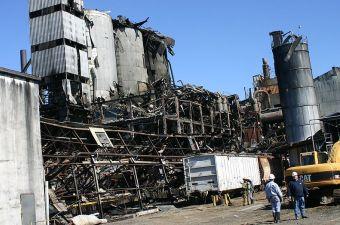
Section Branding
Header Content
Board: Sugar Explosion Was "Entirely Preventable"
Primary Content

More than a year and a half has passed since an explosion that killed 14 workers at the Imperial Sugar refinery near Savannah.
Last night, the blast victims, their families and members of the public gathered to hear a government report on the cause of that deadly explosion.
The report by the U.S. Chemical Safety Board is the second major government report on the Imperial Sugar explosion and the second to fault the company for lax maintenance and equipment. It repeats many of the themes of an earlier report by the Occupational Safety and Health Administration.
Specifically, it blames the explosion on an "entirely preventable" build-up of combustible sugar dust. The findings were delivered in a packed hotel ballroom in polite exchanges between USCSB members and their staff, like this between board member William Wright and investigator John Vorderbrueggen:
Wright: "Mister Vorderbrueggen, let me ask you your professional opinion. Had the installation of the stainless steel cover on the conveyor system included a dust collection or mitigation system, do you believe this tragic event might have been prevented?"
Vorderbrueggen: "The short answer is, it probably would not have occured."
Investigators said, Imperial Sugar managers knew about the dangers of combustible dust but did not take steps to control the hazards. The report said, managers were lulled into a sense of complacency since they escaped several dust-related accidents prior to last year without major injuries.
The 2008 Port Wentworth disaster, however, changed everything. A video re-creation showing exactly how the blast took place made that perfectly clear. The video included depictions of animated plant workers and sounds of explosions.
Several members of the audience clutched hands and put arms around one another during the video. It was the first time the video was shown. And for many, it was painful to watch.
After the meeting, Imperial Sugar worker Patricia Grant-Singleton, who was at the refinery at the time of the explosion, said she "shut down" after the video.
"After I seen the animation, it was like, I was in a daze," Singleton said. "It's just like, you're throwing me back there."
Singleton was disappointed in the report. She was hoping it would go beyond earlier findings and the well known cause of combustible dust.
"You know how you've already been hearing talk about what happened," Singleton said. "Really to me, it's nothing new."
Also not new in the report is a recommendation once again calling on OSHA to regulate on combustible dust. The same board made the same recommendation years before the blast.
OSHA's regulatory process, however, could take years, and critics say, it's tainted by an unwillingness to confront industry. A union representative called the report a delaying tactic for industry to avoid regulations on dust.
To that, board chairman John Bresland refered critics to OSHA.
"If they're concerned about lack of action in developing the regulation, we're not really the best people to talk to about it," Bresland said. "They really should go to OSHA and talk to them. The only power we have is, number one, making the recommendations, and number two, the bully pulpit."
Efforts to regulate industry for combustible dust also have failed in the U.S. Senate. For its part, Imperial Sugar made a statement welcoming the report and promising to rebuild the plant to industry-leading safety standards. The company is appealing a multi-million dollar OSHA fine over its practices. It also faces multiple lawsuits, the first of which may be heard next year.
Tags: Port Wentworth, Imperial Sugar Refinery, Occupational Safety and Health Administration, OSHA, Morning Edition, Imperial Sugar, Chemical Safety Board, USCSB
